Uranium mining
 Bashny.Net
Bashny.Net
Kazakhstan ranked second in the world in explored reserves of uranium. Victor Magdeyev went on the road again - this time he visited several major uranium companies of Kazakhstan, to see with their own eyes how it is produced and used in the production of a chemical element.
41 photo.
via
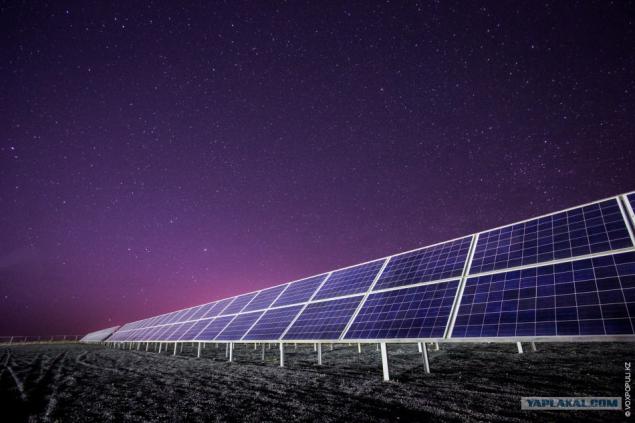
Generally, uranium is mined in three ways: mining, quarry and underground leaching method. In Kazakhstan, only used the latter method, it is safest for humans and the environment. Thanks to him, the level of radiation in the field is not higher than in any major city, stuffed with a variety of electronic devices.
In order to obtain uranium in situ leach necessary sulfuric acid. So the first thing we went to Zhanakorgan district Kyzylorda region, where the sulfuric acid plant (RMS).
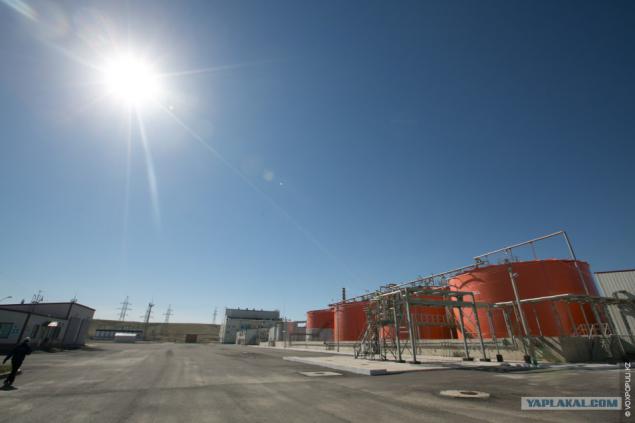
Just a couple of years ago for the production of sulfuric acid purchased uranium abroad, it is now produced in this CPS. Every year it produces 500 tons of sulfuric acid, while the power of similar plants in neighboring countries half!
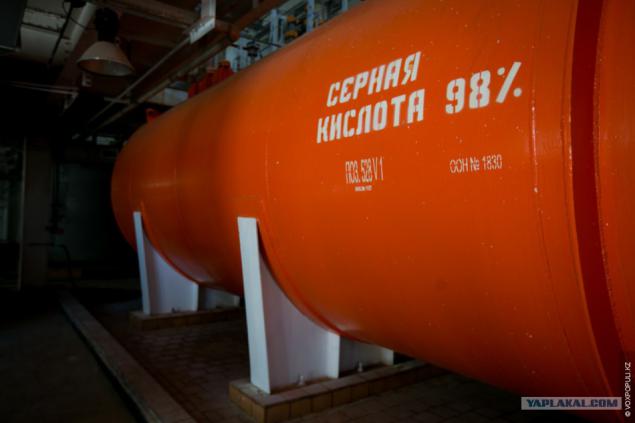
In the sulfuric acid plant employs more than 300 people. It Zhandos, mechanic instrumentation. Zhandos local, he graduated from college "Bolashak" and working here for about a year. I must say that the majority of plant workers - residents of nearby areas. Their training and employment of special attention. It is only narrow specialists come from other regions to work in shifts. The most demanded trade enterprises of all JSC "NAC" Kazatomprom "- Geologist.

This Sabit Kunakbay master:
- I am responsible for the central control panel. My job is to monitor the parameters and analyzes, they should always be normal. I studied in Almaty, KazNTU. Satpayev on metallurgist, in the same specialty Master's degree. Experience in this industry I have 4 years, there toiling for two years.
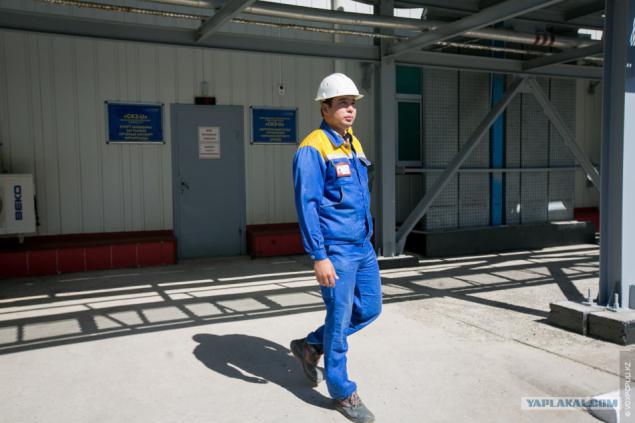
If Sabit monitors the production process on a computer monitor, the driver crawler Zhomart he walks across the enterprise and check if everything is working properly. The shift camp, where he lives, not only created good living conditions, but also the conditions for outdoor activities. Zhomart colleagues likes in his spare time playing football.
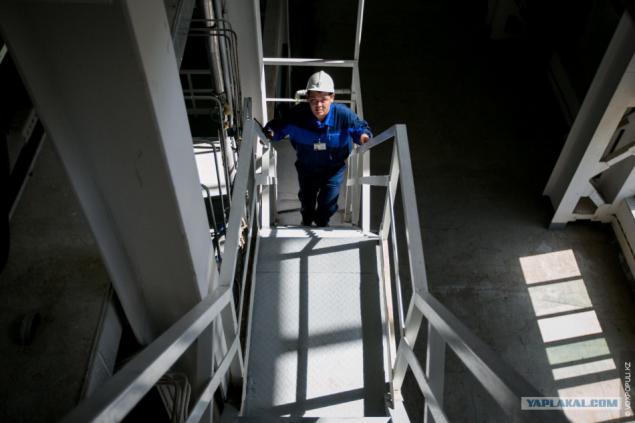
Chief Engineer RMS Aitkali Tleftinov Nikolaevich told about an interesting fact: in the production of sulfuric acid releases massive amounts of steam. It is used to generate electricity to the local power plant, which provides electricity to the whole factory, field camp and even nearby villages.
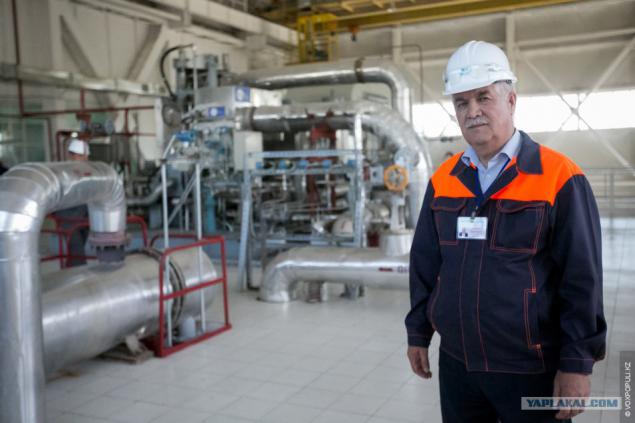
By the way, since solar station CPS looks at night. The panels are entirely manufactured in Kazakhstan - from silicon to the finished assembly.
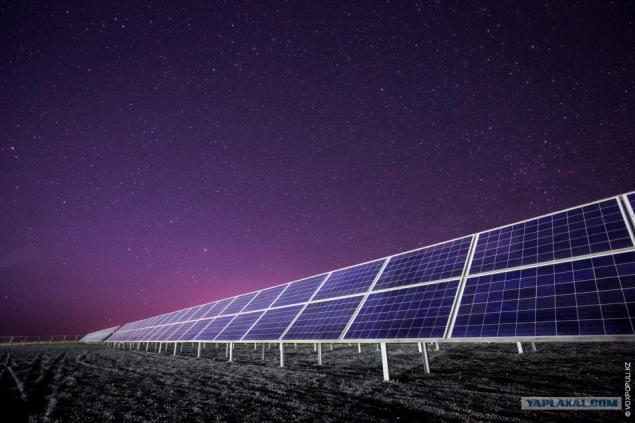
After the sulfuric acid is produced, ready solution through the pipes is directed to a staging station Zhanakorgan Transit. From there it will go to its destination - in the uranium mines. That is a huge reservoir of acid stored before it razolyut for auto transporter and sent to a place of uranium mining. State transit station for about 80 people, of whom only five women.
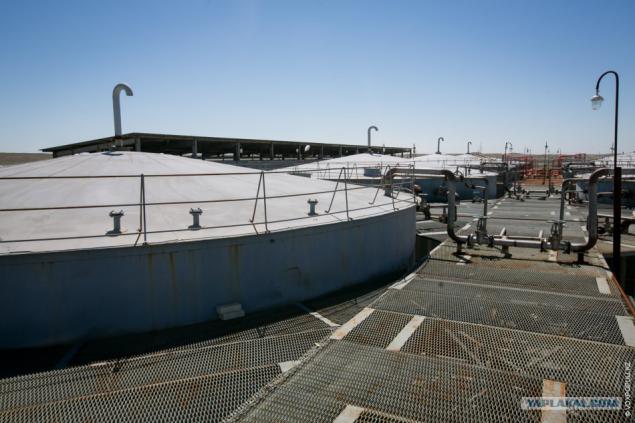
Nurylbay Akshalov - one of the most sought-after workers at the plant, its specialty called "slivschik-acid filler." It is responsible for as sulfuric acid falls from the reservoir to animal transport. Given the specificity of the liquid with which to deal, his work is really very responsible.
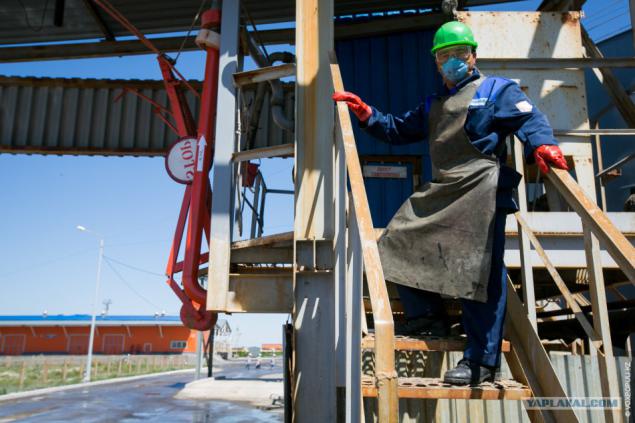
At 20 kilometers from the transit station is a small village Kayden. 180 families live there. For a long time the village had difficulties with drinking water. Thanks station Zhanakorgan Transit problem is resolved. Management of the company ordered to drill a well, and each house was provided with drinking water.
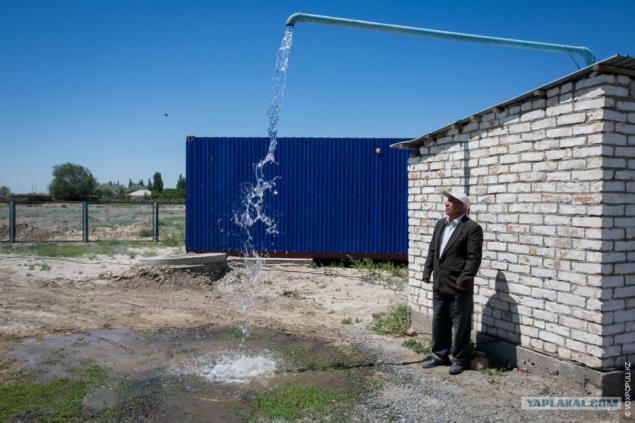
More than forty families of the village in one way or another connected with the RMS, and the transit station. The head of the family Dauth Mekebaev too long time spent in the workplace. And when he went on a holiday, then I began to do his favorite thing - gardening. Just carrying water to the villagers the opportunity to grow different types of crops.

Life in the village, of course, is not easy, in the region is quite harsh natural conditions, but the people here live a very sincere and cordial. They are not rich, but we are ready to share the last, warm and feed the casual visitor. Family Doughty yeah met our team as their own, but still collected goodies on the way back, although it was evident that it is almost the last of their reserves. We first refused, but our hosts took offense in earnest. I had to take!

Hence, the station Zhanakorgan Transit, 6 car carriers make daily flights to the uranium mines of Khorasan-1 and Khorasan-2, which are located here, in the Kyzylorda region. Following the transporters with sulfuric acid, and we moved there. Incidentally, among the workers, there is such a thing as a "nuclear ring." This road network of JSC "NAC" Kazatomprom ", joining the company of the holding in the South Kazakhstan and Kyzylorda regions. The length of 445 km, it is the same as is the distance from Kyzylorda to Shymkent.

But before proceeding to the uranium industry, will tell you more about a company that has a great importance in the overall process - is of "Volkovgeologiya." This geological exploration facility with extensive experience in the study of uranium deposits of all types and also the oldest company in the composition of the JSC "NAC" Kazatomprom ". Besides "Volkovgeologiya" self-repairing mobile drilling rigs, mining and drilling equipment and motor transport. When I asked the attendants, went from the name, I was told that "Volkovgeologiya" had no special meaning - it was invented in the framework of the secrecy of the industry.
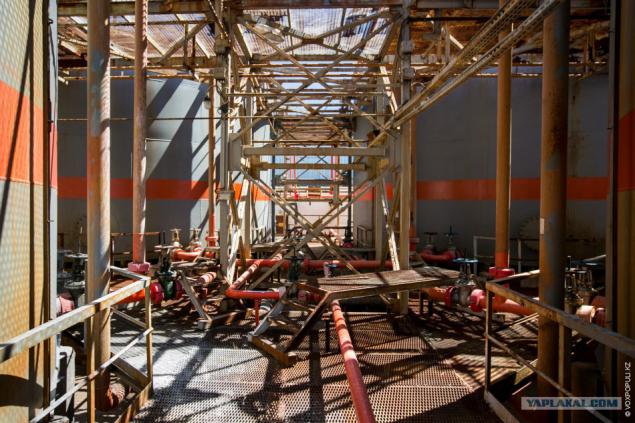
A curious fact: in the history of "Volkovgeologiya" were drilled nearly 40 million running meters. It is 3 times the diameter of planet Earth. You can say three times volkovgeologovchane drilled through the planet.
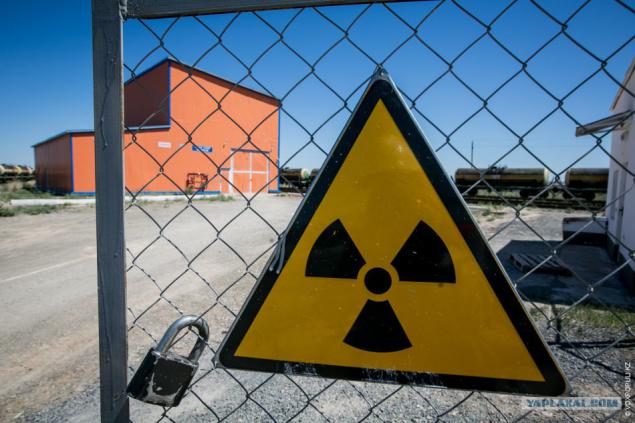
And continuing the theme of drilling rigs. When we got there still went, I, being a man, far from uranium production, to be honest, a little afraid to go there. Still uranium, radiation ... I expected to see the opening of the well, in which all will boil, and requests the frame. As a result, it was not so spectacular, but safe. Because the entire process is completely underground and the workers are not in contact with the ore.
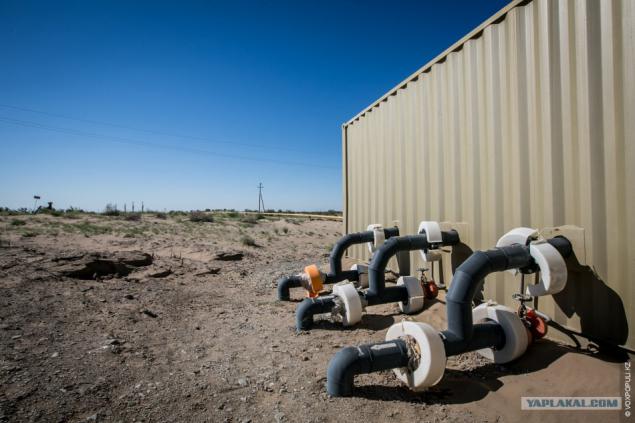
Total system of JSC "NAC" Kazatomprom "20 operating mines located in South Kazakhstan, Kyzylorda and Akmola oblasts. Every hour, these enterprises produced 2, 6 tons of uranium.
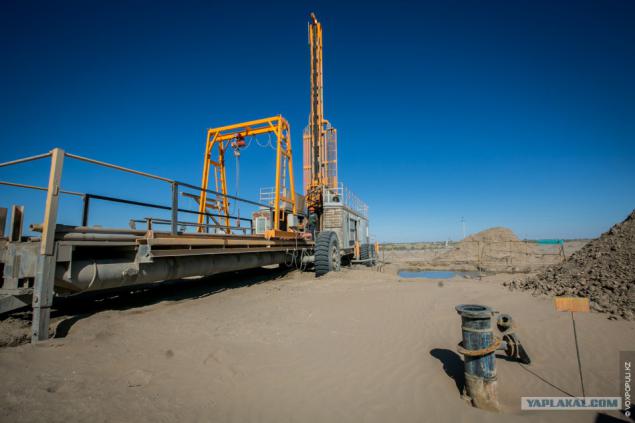
Mining ISL begins with drilling. It Bakhytzhan Jumabekov driver rig. In the uranium mining enterprises of women is six times less than that of men: from 6592 employees in 1124 only women.
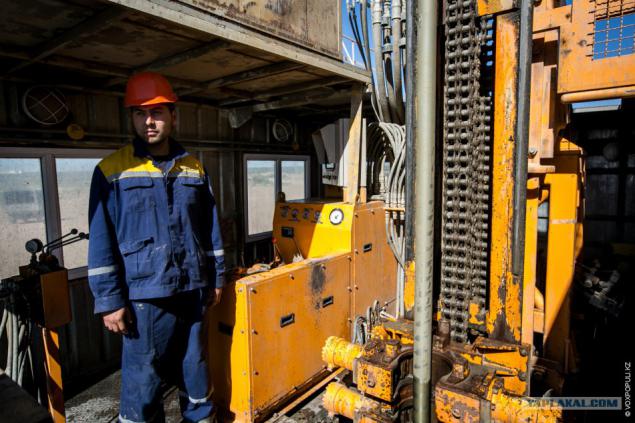
After graduating from college Kentau Bakhytzhan 3 years working in the drilling industry. Labor in shifts: 15 days in the mine, 15 days at home.

During the tour, we were told that the proven reserves of uranium in Kazakhstan for more than 1 700 000 tonnes. If we consider that the population is about 17,145,000 inhabitants, to every citizen of Kazakhstan accounted for nearly 100 kg of natural uranium.

After Bakytzshan colleagues drilled wells, pipes laid therein and thereon a strong pressure is pumped into the same solution of sulfuric acid. The acid reacts with the species, the uranium is removed, it enters the acid, and it is pumped with the other hand, already enriched uranium salts. From this solution, pumped from the ground, then removed the metal itself. As I said, the whole process takes place underground and hidden from the human eye. All very high-tech and quite scary.

Solution enriched uranium salts, this is not the final product. He will go through several stages of chemical treatment to be "unfit for consumption»
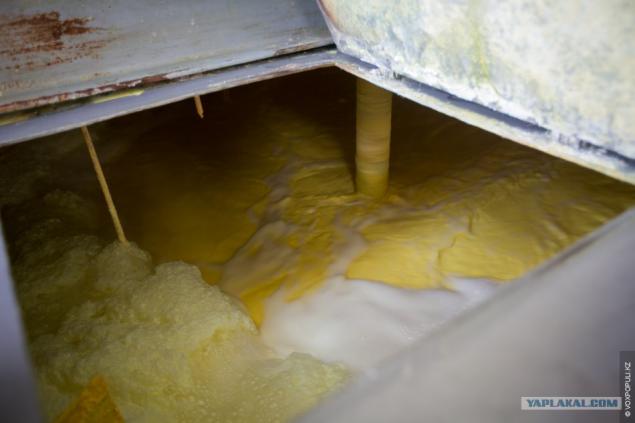
This solution is called trademark desorbate uranium, under the influence of a reagent obtained concentrate natural uranium - yellow cake.

This is the "yellow gold" is the end product of the enterprise, it contains about 50% pure uranium. His left packed in special containers - and the product is ready to ship.

All facilities required to present a man with a dosimeter, which measures the level of radiation around us. Never sensor is not beeped a warning as well as radiation directly at the mines did not exceed the permissible norms for human life. The average radiation background in the uranium-mining villages in Kazakhstan is 0, 15 mSv / h. For example, in Kyzylorda, Shymkent and Astana, the average value of - 0, 12 mSv / h in Aktau - 0, 08 mSv / h, in Ust-Kamenogorsk - 0, 18 mSv / h. Data on the radiation background is always available on-site Kazhydromet.
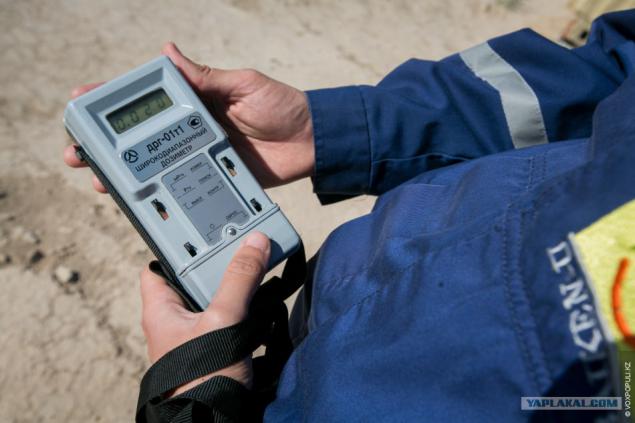
To find out what to do with the extracted uranium, we went to the other end of the country - in Ust-Kamenogorsk on the Ulba Metallurgical Plant (UMP).
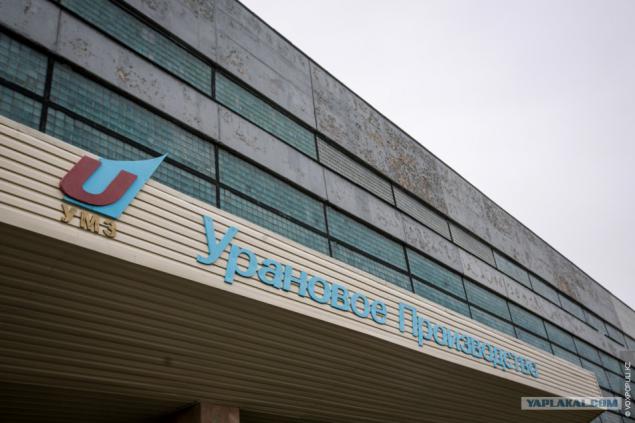
It is at this company that exists since 1949, uranium produces fuel pellets for nuclear reactors. One fuel pellets of uranium dioxide mass 4, 5 g, produced in the UMP, releases energy equivalent to burning 882 kg of wood, 550 kg of coal or 500 kg of oil.

This is one of the world's largest complex for the production of uranium fuel for nuclear power plants. Incidentally, the fuel for a nuclear reactor of the first plane in the world, where the reactor was replaced by an aircraft engine was made of ceramics based on beryllium oxide and highly enriched uranium is here in UMP.
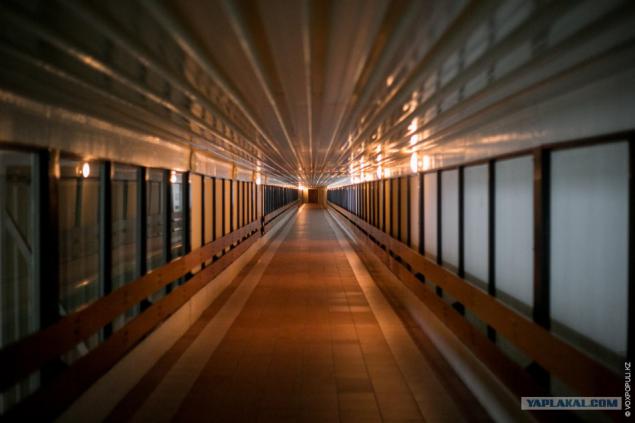
The manufacturing process of the tablets have not shown us - the production of a top-secret! But a tour of the plant conducted. And told a lot of interesting. For example, in the construction of the first ever lunar rover, explore the natural satellite of the Earth, it has been widely used beryllium produced in Ust-Kamenogorsk plant.

Or here's another interesting fact: to produce 1 MW of energy must be expended approximately 1 gram of uranium or 2,800 tons of high quality coal.

Dmitry Borisovich Slobodin, head of the department of environmental protection, during the tour said that we, ordinary people, interested, perhaps most of all - how to protect themselves from the radiation. Many are worried about the question of whether alcohol is able to bring the body of harmful substances resulting from radiation. It turned out that all these stories. We also learned that the UMP emissions into the air of Ust-Kamenogorsk are only 0, 09 per cent of total industrial emissions to the atmosphere of the city.
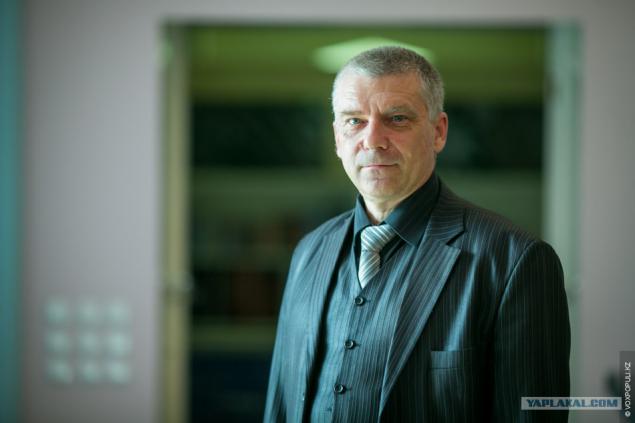
My uranium story would be incomplete if I did not see the place where the used fuel of the future. Therefore, the last object of my route was the Mangistau Atomic Energy Complex (MAEC), which is located in the city of Aktau on the Caspian Sea.

I was surprised to learn that in the Mangistau region is no fresh water. It is obtained in the Mangistau nuclear power plant, processing salt water of the Caspian Sea. MAEC is also the only source of energy and heat for residents of Aktau and the majority of settlements in the area. Daily plant recycles 3 million cubic meters of sea water, of which 357 thousand. Cu. m are used for preparation of drinking water.
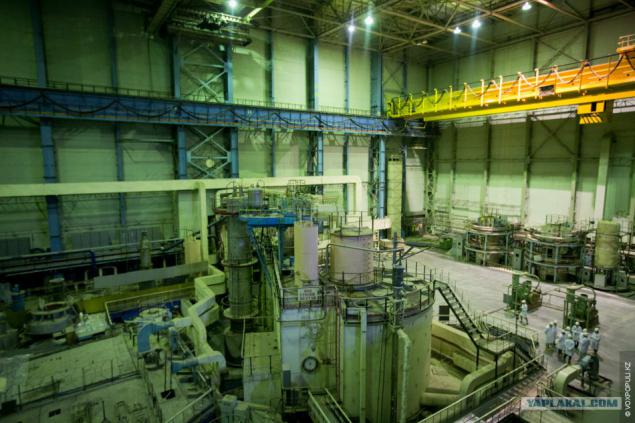
MAEK was launched in 1968 and is the world's first fast breeder reactor has been built here. This reactor BN-350 on the Mangyshlak Peninsula (now Aktau), which is successful and trouble-free worked from 1973 to 1998, five years longer than the design life. For 25 years the plant has not been allowed any accident or emergency situation anymore. "The influence of the reactor BN-350 in Aktau, the radiation situation in the area and not found" - such conclusions were made after conducted by the Institute of Radiation Safety and Ecology study commissioned by the administration of Mangistau region during decommissioning.

Output BN-350 reactor decommissioning has become the richest in the world of sensation. If the safe discharge of sodium PFR reactor in England was carried out for 2 years, in France at the reactor PHENIX - 2, 5 years, in Kazakhstan, this work took only 18 hours! This was made possible by the invention of Kazakh nuclear scientists unit, assembled by analogy with the usual trap.

Spent fuel is stored in the Aktau nuclear power plant complex "Baikal-1" of the Semipalatinsk test site. 695 spent nuclear fuel assemblies Aktau nuclear power plant have been discharged from the reactor vessel in just 9 months. For comparison, the same work at the reactor PFR, where the assembly was less than 300, taken from the British nuclear workers 2, 5 years. At the same time work in Kazakhstan were conducted without a single accident or incident. And I must say that never before Kazakhstan's example in the world of such a large number of highly spent fuel does not move at such great distance: it is absolutely safe "have driven" by our country 3,000 km.

But back to the very plant. With the collapse of the Soviet Union, as well as for the whole country, for the company fell on hard times - the workers have not seen the money. Old-timers say that they were given salary chickens, shoes, stockings ... Up until 2003 Energy was in a deplorable state: the average salary was 25 thousand tenge (5000 rubles), about 60% of the equipment was worn out, needed urgent repairs.
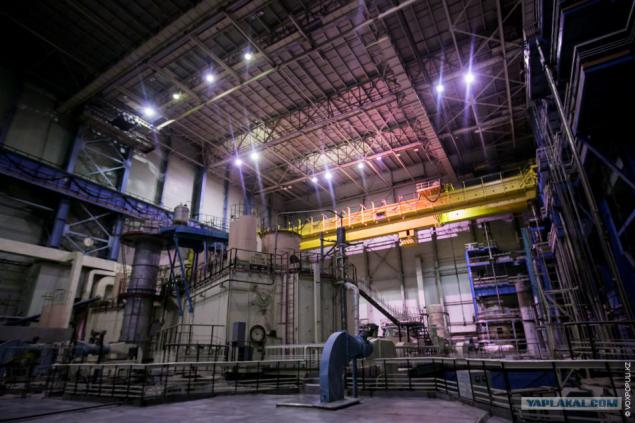
In 2003 the company bought the JSC "NAC" Kazatomprom "and the situation began to gradually change for the better: decreased outflow of professionals, renovated office space, raised salaries. Now the average salary at MAEC is about 185 thousand tenge (37 000 rubles). And most importantly, the production was automated to minimize the risk of accidental failures due to human error.
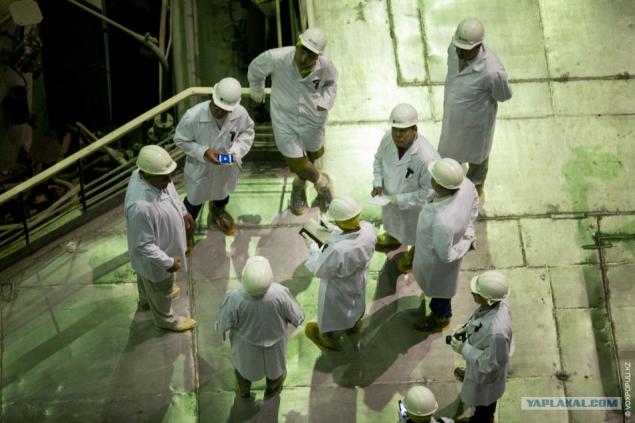
While nuclear power is difficult to resist and do not ask about Chernobyl, Fukushima and other nuclear accidents ... do you, our specialists any conclusions from the tragic experience of other countries? All my questions answered Chief Engineer of the BN-350 Andrey V. Rovneyko:
- Since the Chernobyl accident was a long time, scientists and technology in place is not worth it. It made a lot of tough requirements relating to security systems equipment. To the uninitiated it was clear, it is possible to carry out such an analogy: compare the old "Zaporozhets" and "Mercedes". A similar difference between the old and new reactors.
Everyone has heard about the tragedy that happened at the nuclear submarine "Kursk". The reactor got into a serious accident, he was unharmed. After removal from the submarine it can be set to another vessel. The experience that has been obtained in the study of the Kursk reactor and operation of other Russian nuclear power plants, is taken into account in the construction of new facilities and renovation of old ones. The update of our reactors and use advanced materials. After all, we are not only generates electricity, heat, do research, and constantly improve the system security. For us it is a priority.

After all, nuclear production can be environmentally and radiation safety. Passing on the facilities of JSC "NAC" Kazatomprom ", I was convinced of it personally. I was most impressed by what enormous energy allocates one fuel pellet.
Posted in [mergetime] 1406100517 [/ mergetime]
That's all I wanted to say!
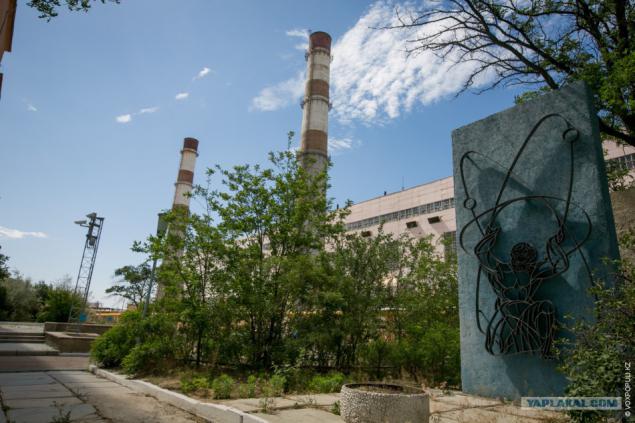
41 photo.
via

Generally, uranium is mined in three ways: mining, quarry and underground leaching method. In Kazakhstan, only used the latter method, it is safest for humans and the environment. Thanks to him, the level of radiation in the field is not higher than in any major city, stuffed with a variety of electronic devices.
In order to obtain uranium in situ leach necessary sulfuric acid. So the first thing we went to Zhanakorgan district Kyzylorda region, where the sulfuric acid plant (RMS).

Just a couple of years ago for the production of sulfuric acid purchased uranium abroad, it is now produced in this CPS. Every year it produces 500 tons of sulfuric acid, while the power of similar plants in neighboring countries half!

In the sulfuric acid plant employs more than 300 people. It Zhandos, mechanic instrumentation. Zhandos local, he graduated from college "Bolashak" and working here for about a year. I must say that the majority of plant workers - residents of nearby areas. Their training and employment of special attention. It is only narrow specialists come from other regions to work in shifts. The most demanded trade enterprises of all JSC "NAC" Kazatomprom "- Geologist.

This Sabit Kunakbay master:
- I am responsible for the central control panel. My job is to monitor the parameters and analyzes, they should always be normal. I studied in Almaty, KazNTU. Satpayev on metallurgist, in the same specialty Master's degree. Experience in this industry I have 4 years, there toiling for two years.

If Sabit monitors the production process on a computer monitor, the driver crawler Zhomart he walks across the enterprise and check if everything is working properly. The shift camp, where he lives, not only created good living conditions, but also the conditions for outdoor activities. Zhomart colleagues likes in his spare time playing football.

Chief Engineer RMS Aitkali Tleftinov Nikolaevich told about an interesting fact: in the production of sulfuric acid releases massive amounts of steam. It is used to generate electricity to the local power plant, which provides electricity to the whole factory, field camp and even nearby villages.

By the way, since solar station CPS looks at night. The panels are entirely manufactured in Kazakhstan - from silicon to the finished assembly.

After the sulfuric acid is produced, ready solution through the pipes is directed to a staging station Zhanakorgan Transit. From there it will go to its destination - in the uranium mines. That is a huge reservoir of acid stored before it razolyut for auto transporter and sent to a place of uranium mining. State transit station for about 80 people, of whom only five women.

Nurylbay Akshalov - one of the most sought-after workers at the plant, its specialty called "slivschik-acid filler." It is responsible for as sulfuric acid falls from the reservoir to animal transport. Given the specificity of the liquid with which to deal, his work is really very responsible.

At 20 kilometers from the transit station is a small village Kayden. 180 families live there. For a long time the village had difficulties with drinking water. Thanks station Zhanakorgan Transit problem is resolved. Management of the company ordered to drill a well, and each house was provided with drinking water.

More than forty families of the village in one way or another connected with the RMS, and the transit station. The head of the family Dauth Mekebaev too long time spent in the workplace. And when he went on a holiday, then I began to do his favorite thing - gardening. Just carrying water to the villagers the opportunity to grow different types of crops.

Life in the village, of course, is not easy, in the region is quite harsh natural conditions, but the people here live a very sincere and cordial. They are not rich, but we are ready to share the last, warm and feed the casual visitor. Family Doughty yeah met our team as their own, but still collected goodies on the way back, although it was evident that it is almost the last of their reserves. We first refused, but our hosts took offense in earnest. I had to take!

Hence, the station Zhanakorgan Transit, 6 car carriers make daily flights to the uranium mines of Khorasan-1 and Khorasan-2, which are located here, in the Kyzylorda region. Following the transporters with sulfuric acid, and we moved there. Incidentally, among the workers, there is such a thing as a "nuclear ring." This road network of JSC "NAC" Kazatomprom ", joining the company of the holding in the South Kazakhstan and Kyzylorda regions. The length of 445 km, it is the same as is the distance from Kyzylorda to Shymkent.

But before proceeding to the uranium industry, will tell you more about a company that has a great importance in the overall process - is of "Volkovgeologiya." This geological exploration facility with extensive experience in the study of uranium deposits of all types and also the oldest company in the composition of the JSC "NAC" Kazatomprom ". Besides "Volkovgeologiya" self-repairing mobile drilling rigs, mining and drilling equipment and motor transport. When I asked the attendants, went from the name, I was told that "Volkovgeologiya" had no special meaning - it was invented in the framework of the secrecy of the industry.

A curious fact: in the history of "Volkovgeologiya" were drilled nearly 40 million running meters. It is 3 times the diameter of planet Earth. You can say three times volkovgeologovchane drilled through the planet.

And continuing the theme of drilling rigs. When we got there still went, I, being a man, far from uranium production, to be honest, a little afraid to go there. Still uranium, radiation ... I expected to see the opening of the well, in which all will boil, and requests the frame. As a result, it was not so spectacular, but safe. Because the entire process is completely underground and the workers are not in contact with the ore.

Total system of JSC "NAC" Kazatomprom "20 operating mines located in South Kazakhstan, Kyzylorda and Akmola oblasts. Every hour, these enterprises produced 2, 6 tons of uranium.

Mining ISL begins with drilling. It Bakhytzhan Jumabekov driver rig. In the uranium mining enterprises of women is six times less than that of men: from 6592 employees in 1124 only women.

After graduating from college Kentau Bakhytzhan 3 years working in the drilling industry. Labor in shifts: 15 days in the mine, 15 days at home.

During the tour, we were told that the proven reserves of uranium in Kazakhstan for more than 1 700 000 tonnes. If we consider that the population is about 17,145,000 inhabitants, to every citizen of Kazakhstan accounted for nearly 100 kg of natural uranium.

After Bakytzshan colleagues drilled wells, pipes laid therein and thereon a strong pressure is pumped into the same solution of sulfuric acid. The acid reacts with the species, the uranium is removed, it enters the acid, and it is pumped with the other hand, already enriched uranium salts. From this solution, pumped from the ground, then removed the metal itself. As I said, the whole process takes place underground and hidden from the human eye. All very high-tech and quite scary.

Solution enriched uranium salts, this is not the final product. He will go through several stages of chemical treatment to be "unfit for consumption»

This solution is called trademark desorbate uranium, under the influence of a reagent obtained concentrate natural uranium - yellow cake.

This is the "yellow gold" is the end product of the enterprise, it contains about 50% pure uranium. His left packed in special containers - and the product is ready to ship.

All facilities required to present a man with a dosimeter, which measures the level of radiation around us. Never sensor is not beeped a warning as well as radiation directly at the mines did not exceed the permissible norms for human life. The average radiation background in the uranium-mining villages in Kazakhstan is 0, 15 mSv / h. For example, in Kyzylorda, Shymkent and Astana, the average value of - 0, 12 mSv / h in Aktau - 0, 08 mSv / h, in Ust-Kamenogorsk - 0, 18 mSv / h. Data on the radiation background is always available on-site Kazhydromet.

To find out what to do with the extracted uranium, we went to the other end of the country - in Ust-Kamenogorsk on the Ulba Metallurgical Plant (UMP).

It is at this company that exists since 1949, uranium produces fuel pellets for nuclear reactors. One fuel pellets of uranium dioxide mass 4, 5 g, produced in the UMP, releases energy equivalent to burning 882 kg of wood, 550 kg of coal or 500 kg of oil.

This is one of the world's largest complex for the production of uranium fuel for nuclear power plants. Incidentally, the fuel for a nuclear reactor of the first plane in the world, where the reactor was replaced by an aircraft engine was made of ceramics based on beryllium oxide and highly enriched uranium is here in UMP.

The manufacturing process of the tablets have not shown us - the production of a top-secret! But a tour of the plant conducted. And told a lot of interesting. For example, in the construction of the first ever lunar rover, explore the natural satellite of the Earth, it has been widely used beryllium produced in Ust-Kamenogorsk plant.

Or here's another interesting fact: to produce 1 MW of energy must be expended approximately 1 gram of uranium or 2,800 tons of high quality coal.

Dmitry Borisovich Slobodin, head of the department of environmental protection, during the tour said that we, ordinary people, interested, perhaps most of all - how to protect themselves from the radiation. Many are worried about the question of whether alcohol is able to bring the body of harmful substances resulting from radiation. It turned out that all these stories. We also learned that the UMP emissions into the air of Ust-Kamenogorsk are only 0, 09 per cent of total industrial emissions to the atmosphere of the city.

My uranium story would be incomplete if I did not see the place where the used fuel of the future. Therefore, the last object of my route was the Mangistau Atomic Energy Complex (MAEC), which is located in the city of Aktau on the Caspian Sea.

I was surprised to learn that in the Mangistau region is no fresh water. It is obtained in the Mangistau nuclear power plant, processing salt water of the Caspian Sea. MAEC is also the only source of energy and heat for residents of Aktau and the majority of settlements in the area. Daily plant recycles 3 million cubic meters of sea water, of which 357 thousand. Cu. m are used for preparation of drinking water.

MAEK was launched in 1968 and is the world's first fast breeder reactor has been built here. This reactor BN-350 on the Mangyshlak Peninsula (now Aktau), which is successful and trouble-free worked from 1973 to 1998, five years longer than the design life. For 25 years the plant has not been allowed any accident or emergency situation anymore. "The influence of the reactor BN-350 in Aktau, the radiation situation in the area and not found" - such conclusions were made after conducted by the Institute of Radiation Safety and Ecology study commissioned by the administration of Mangistau region during decommissioning.

Output BN-350 reactor decommissioning has become the richest in the world of sensation. If the safe discharge of sodium PFR reactor in England was carried out for 2 years, in France at the reactor PHENIX - 2, 5 years, in Kazakhstan, this work took only 18 hours! This was made possible by the invention of Kazakh nuclear scientists unit, assembled by analogy with the usual trap.

Spent fuel is stored in the Aktau nuclear power plant complex "Baikal-1" of the Semipalatinsk test site. 695 spent nuclear fuel assemblies Aktau nuclear power plant have been discharged from the reactor vessel in just 9 months. For comparison, the same work at the reactor PFR, where the assembly was less than 300, taken from the British nuclear workers 2, 5 years. At the same time work in Kazakhstan were conducted without a single accident or incident. And I must say that never before Kazakhstan's example in the world of such a large number of highly spent fuel does not move at such great distance: it is absolutely safe "have driven" by our country 3,000 km.

But back to the very plant. With the collapse of the Soviet Union, as well as for the whole country, for the company fell on hard times - the workers have not seen the money. Old-timers say that they were given salary chickens, shoes, stockings ... Up until 2003 Energy was in a deplorable state: the average salary was 25 thousand tenge (5000 rubles), about 60% of the equipment was worn out, needed urgent repairs.

In 2003 the company bought the JSC "NAC" Kazatomprom "and the situation began to gradually change for the better: decreased outflow of professionals, renovated office space, raised salaries. Now the average salary at MAEC is about 185 thousand tenge (37 000 rubles). And most importantly, the production was automated to minimize the risk of accidental failures due to human error.

While nuclear power is difficult to resist and do not ask about Chernobyl, Fukushima and other nuclear accidents ... do you, our specialists any conclusions from the tragic experience of other countries? All my questions answered Chief Engineer of the BN-350 Andrey V. Rovneyko:
- Since the Chernobyl accident was a long time, scientists and technology in place is not worth it. It made a lot of tough requirements relating to security systems equipment. To the uninitiated it was clear, it is possible to carry out such an analogy: compare the old "Zaporozhets" and "Mercedes". A similar difference between the old and new reactors.
Everyone has heard about the tragedy that happened at the nuclear submarine "Kursk". The reactor got into a serious accident, he was unharmed. After removal from the submarine it can be set to another vessel. The experience that has been obtained in the study of the Kursk reactor and operation of other Russian nuclear power plants, is taken into account in the construction of new facilities and renovation of old ones. The update of our reactors and use advanced materials. After all, we are not only generates electricity, heat, do research, and constantly improve the system security. For us it is a priority.

After all, nuclear production can be environmentally and radiation safety. Passing on the facilities of JSC "NAC" Kazatomprom ", I was convinced of it personally. I was most impressed by what enormous energy allocates one fuel pellet.
Posted in [mergetime] 1406100517 [/ mergetime]
That's all I wanted to say!

Tags
See also
What sells Russia than wood, oil and gas?
What Russian exports to the world market than oil?
Apple has captured 20% of the market wearable electronics, and came in second place in the rankings after FitBit
A new method of uranium mining open access to infinite nuclear energy
60 facts about Singapore through the eyes of Russians (7 photos)
The joy of victory
China: World Factory
















